
P-40E (Mark 1) Kittyhawk in 1942 uniform of 111 (F) Squadron. The first two letters were the Squadron Code Letters assigned to 111 Squadron. However, on October 18, 1942, orders came from on high that no Squadron Code Letters were to appear on any RCAF aircraft. Within the day, all such code letters disappeared from RCAF aircraft. It is assumed that the order was issued for reasons of security.
This drawing of the Kittyhawk (AL194) was done by R. Ward, published in Profile Publications, No. 136, page 15, 1966.
The Aircraft of No.111 (F) Squadron
The Curtiss P-40 Kittyhawk
TThe mainstay of 111 (F for fighter) Squadron was the Curtiss P-40 Kittyhawk. The squadron was designed to be a fighter squadron and the first aircraft type they received was the P-40 Mark 1 (P-40E). When at full strength, they had 20 P-40Es. The squadron began to receive P-40Ks (Kittyhawk III) in August, 1942 and for the rest of the Aleutian Campaign they had about 8-10 of each variant. The P-40K was slightly heavier and more powerful than the E. The E, perhaps because it was a bit lighter, could cruise slightly faster (300 mph vs 290 mph) but the K could reach slightly greater maximum speed (362 mph vs 354 mph). Both variants had an operational range of 700 miles. They could climb to 28,000 – 29,000 feet at a rate of 2,000 feet per minute. They were both equipped with six 50 caliber machine guns. Both could be outfitted with bomb racks and extra fuel tanks. For the last few months of operating as 111 Squadron, (at Patricia Bay), the squadron was equipped with P-40 Ns (Mark IV). The N was the last production version of the P-40. It was designed to be lighter, and therefore more able to climb quickly, but the penalty was two fewer machine guns than the earlier versions.
P-40s were built by the Curtiss-Wright Corporation Airplane Division in Buffalo, New York, for about $45,000 apiece. In all, Curtiss built 13,738 of them. Only two other American fighters were produced in greater numbers, the P-51 Mustang and the Republic P-47 Thunderbolt. Wikipedia states that, as of 2020, there were 28 P-40s in the world that are still airworthy.
P-40s were built by the Curtiss-Wright Corporation Airplane Division in Buffalo, New York, for about $45,000 apiece. In all, Curtiss built 13,738 of them. Only two other American fighters were produced in greater numbers, the P-51 Mustang and the Republic P-47 Thunderbolt. Wikipedia states that, as of 2020, there were 28 P-40s in the world that are still airworthy.
Here is a list of the P-40s that appeared in 111 Squadron's complement when they served in Canada and Alaska:
Type RAF# RCAF# Sqn ID First appearance in 111 Incidents
P40 E, Mark 1 AK863 1044 N November, 1941 Category A Crash, August, 1943, 133 Squadron
P40 E, Mark 1 AK869 1046 November, 1941 Category A Crash, June 24, 1942, Pilot Orthman OK
P40 E, Mark 1 AK875 1047 T November, 1941 At US National Air and Space Museum
P40 E, Mark 1 AK881 1048 November, 1941 Category A crash: May, 1942 Pilot Christy killed
P40 E, Mark 1 AK887 1049 November, 1941 Category A crash: December, 1941 Pilot Pierce killed
P40 E, Mark 1 AK893 1050 B November, 1941 Workhorse for 111, transferred to 14 Sqn. Rebuilt, New York, 1988
P40 E Mark 1 AK899 1051 November, 1941 Spent most of 1942 under repairs; transferred in November, 1943
P40 E, Mark 1 AK905 1052 D November, 1941 Not used much; under repair a lot.
P40 E, Mark 1 AK911 1053 K November, 1941 Transferred to 14 squadron, Fall, 1943
P40 E, Mark 1 AK940 1058 E November, 1941 Transferred to 14 squadron, Fall, 1943
P40 E, Mark 1 AK954 1061 F November, 1941 Category A crash: July, 1942, Pilot Kerwin killed
P40 E, Mark 1 AK968 1062 H November, 1941 Undercarriage collapse, April, 1942. Not used by 111 again
P40 E, Mark 1 AK982 1065 L November, 1941 Undercarriage collapse, May, 1942. Not used by 111 again
P40 E, Mark 1 AK983 1066 September, 1943 From 133 Squadron; Category C (guns) November, 1943
P40 E, Mark 1 AK989 1069 November, 1941 Category A crash, Jul, 1942 Pilot Schwalm OK enroute to NakNek
P40 E, Mark 1 AK996 1070 S November, 1941 Category A crash: July, 1942, Pilot Maxmen killed
P40 E, Mark 1 AL110 1072 M November, 1941 I think it was transferred to 14 squadron, Summer, 1943
P40 E, Mark 1 AL124 1075 S Per Walker, this a/c served with 111 but I have no record
P40 E, Mark 1 AL138 1079 G January, 1942 Category A crash: July, 1942, Pilot Lennon killed
P40 E, Mark 1 AL 144 1080 According to Walker, 1080 serve with 111 in late 1943, after 14 Sqn
P40 E, Mark 1 AL166 1083 O Category A crash: July, 1942, Pilot Baird killed
P40 E, Mark 1 AL180 1085 Category A crash: January, 1942, Pilot Orthman OK
P40 E, Mark 1 AL194 1087 V January, 1942 Category A crash: after 111 sqn, May, 1944
P40 E, Mark 1 AL201 1088 H January, 1942 Category A crash: July, 1942, Pilot Whiteside killed
P40 E, Mark 1 AL212 1090 January, 1942 Category A crash: April, 1942, Pilot Stapleton killed
P40 E, Mark 1 ? ? P ? Blew blast tube, wing replaced, Sep 19, 1942
P40 E, Mark 1 AL214 1091 X January, 1942 Workhorse for 111; to 14 Sqn in July, 1943
P40 E, Mark 1 AL218 1093 W January, 1942 After 111 Sqn: Category A crash, 9/6/43
P40 E, Mark 1 AL222 1095 October, 1943 In 111 for only a few weeks in Fall, 1943, from 118 Sqn
P40 E, Mark 1 AL227 1098 October, 1943 In 111 for only a few weeks in Fall, 1943, from 118 Sqn
P40 K-1-CU Mark III 42-45921 Summer, 1942 Workhorse for 111; to 14 Sqn in July, 1943
P40 K-1-CU Mark III 42-45944 R Summer, 1942 Workhorse for 111; to 14 Sqn in July, 1943
P40 K-1-CU Mark III 42-45945 F Summer, 1942 Workhorse for 111; to 14 Sqn in July, 1943
P40 K-1-CU Mark III 42-45951 A Summer, 1942 Workhorse for 111; to 14 Sqn in July, 1943
P40 K-1-CU Mark III 42-45952 Summer, 1942 Workhorse for 111; to 14 Sqn in July, 1943
P40 K-1-CU Mark III 42-45954 G Summer, 1942 Workhorse for 111; Category A accident, Feb, 1943
P40 K-1-CU Mark III 42-45977 Y Summer, 1942 Workhorse for 111; to 14 Sqn in August 1943
P40 K-1-CU Mark III 42-46003 Summer, 1942 Workhorse for 111; to 14 Sqn in July, 1943
P40 K-1-CU Mark III 42-46004 S Summer, 1942 Workhorse for 111; to 14 Sqn in July, 1943
P40 N Mark IV 2105838 Fall, 1943 Used for Patrols in 111 Sqn's last few weeks in Patricia Bay
P40 N Mark IV 2105839 Fall, 1943 Used for Patrols in 111 Sqn's last few weeks in Patricia Bay
P40 N Mark IV 2105840 Fall, 1943 Used for Patrols in 111 Sqn's last few weeks in Patricia Bay
P40 N Mark IV 2105842 Fall, 1943 Used for Patrols in 111 Sqn's last few weeks in Patricia Bay
P40 N Mark IV 2105844 Fall, 1943 Used for Patrols in 111 Sqn's last few weeks in Patricia Bay
P40 N Mark IV 2105861 Fall, 1943 Used for Patrols in 111 Sqn's last few weeks in Patricia Bay
P40 N Mark IV 2105862 Fall, 1943 Used for Patrols in 111 Sqn's last few weeks in Patricia Bay
P40 N Mark IV 2105863 Fall, 1943 Used for Patrols in 111 Sqn's last few weeks in Patricia Bay
P40 N Mark IV 2105864 Fall, 1943 Used for Patrols in 111 Sqn's last few weeks in Patricia Bay
P40 N Mark IV 2105866 Fall, 1943 Used for Patrols in 111 Sqn's last few weeks in Patricia Bay
P40 N Mark IV 2105867 Fall, 1943 Used for Patrols in 111 Sqn's last few weeks in Patricia Bay
P40 N Mark IV 2105869 Fall, 1943 Used for Patrols in 111 Sqn's last few weeks in Patricia Bay
P40 N Mark IV 2105871 Fall, 1943 Used for Patrols in 111 Sqn's last few weeks in Patricia Bay
P40 N Mark IV 2105878 Fall, 1943 Used for Patrols in 111 Sqn's last few weeks in Patricia Bay
I am eager to hear of any errors or omissions in this list.
Type RAF# RCAF# Sqn ID First appearance in 111 Incidents
P40 E, Mark 1 AK863 1044 N November, 1941 Category A Crash, August, 1943, 133 Squadron
P40 E, Mark 1 AK869 1046 November, 1941 Category A Crash, June 24, 1942, Pilot Orthman OK
P40 E, Mark 1 AK875 1047 T November, 1941 At US National Air and Space Museum
P40 E, Mark 1 AK881 1048 November, 1941 Category A crash: May, 1942 Pilot Christy killed
P40 E, Mark 1 AK887 1049 November, 1941 Category A crash: December, 1941 Pilot Pierce killed
P40 E, Mark 1 AK893 1050 B November, 1941 Workhorse for 111, transferred to 14 Sqn. Rebuilt, New York, 1988
P40 E Mark 1 AK899 1051 November, 1941 Spent most of 1942 under repairs; transferred in November, 1943
P40 E, Mark 1 AK905 1052 D November, 1941 Not used much; under repair a lot.
P40 E, Mark 1 AK911 1053 K November, 1941 Transferred to 14 squadron, Fall, 1943
P40 E, Mark 1 AK940 1058 E November, 1941 Transferred to 14 squadron, Fall, 1943
P40 E, Mark 1 AK954 1061 F November, 1941 Category A crash: July, 1942, Pilot Kerwin killed
P40 E, Mark 1 AK968 1062 H November, 1941 Undercarriage collapse, April, 1942. Not used by 111 again
P40 E, Mark 1 AK982 1065 L November, 1941 Undercarriage collapse, May, 1942. Not used by 111 again
P40 E, Mark 1 AK983 1066 September, 1943 From 133 Squadron; Category C (guns) November, 1943
P40 E, Mark 1 AK989 1069 November, 1941 Category A crash, Jul, 1942 Pilot Schwalm OK enroute to NakNek
P40 E, Mark 1 AK996 1070 S November, 1941 Category A crash: July, 1942, Pilot Maxmen killed
P40 E, Mark 1 AL110 1072 M November, 1941 I think it was transferred to 14 squadron, Summer, 1943
P40 E, Mark 1 AL124 1075 S Per Walker, this a/c served with 111 but I have no record
P40 E, Mark 1 AL138 1079 G January, 1942 Category A crash: July, 1942, Pilot Lennon killed
P40 E, Mark 1 AL 144 1080 According to Walker, 1080 serve with 111 in late 1943, after 14 Sqn
P40 E, Mark 1 AL166 1083 O Category A crash: July, 1942, Pilot Baird killed
P40 E, Mark 1 AL180 1085 Category A crash: January, 1942, Pilot Orthman OK
P40 E, Mark 1 AL194 1087 V January, 1942 Category A crash: after 111 sqn, May, 1944
P40 E, Mark 1 AL201 1088 H January, 1942 Category A crash: July, 1942, Pilot Whiteside killed
P40 E, Mark 1 AL212 1090 January, 1942 Category A crash: April, 1942, Pilot Stapleton killed
P40 E, Mark 1 ? ? P ? Blew blast tube, wing replaced, Sep 19, 1942
P40 E, Mark 1 AL214 1091 X January, 1942 Workhorse for 111; to 14 Sqn in July, 1943
P40 E, Mark 1 AL218 1093 W January, 1942 After 111 Sqn: Category A crash, 9/6/43
P40 E, Mark 1 AL222 1095 October, 1943 In 111 for only a few weeks in Fall, 1943, from 118 Sqn
P40 E, Mark 1 AL227 1098 October, 1943 In 111 for only a few weeks in Fall, 1943, from 118 Sqn
P40 K-1-CU Mark III 42-45921 Summer, 1942 Workhorse for 111; to 14 Sqn in July, 1943
P40 K-1-CU Mark III 42-45944 R Summer, 1942 Workhorse for 111; to 14 Sqn in July, 1943
P40 K-1-CU Mark III 42-45945 F Summer, 1942 Workhorse for 111; to 14 Sqn in July, 1943
P40 K-1-CU Mark III 42-45951 A Summer, 1942 Workhorse for 111; to 14 Sqn in July, 1943
P40 K-1-CU Mark III 42-45952 Summer, 1942 Workhorse for 111; to 14 Sqn in July, 1943
P40 K-1-CU Mark III 42-45954 G Summer, 1942 Workhorse for 111; Category A accident, Feb, 1943
P40 K-1-CU Mark III 42-45977 Y Summer, 1942 Workhorse for 111; to 14 Sqn in August 1943
P40 K-1-CU Mark III 42-46003 Summer, 1942 Workhorse for 111; to 14 Sqn in July, 1943
P40 K-1-CU Mark III 42-46004 S Summer, 1942 Workhorse for 111; to 14 Sqn in July, 1943
P40 N Mark IV 2105838 Fall, 1943 Used for Patrols in 111 Sqn's last few weeks in Patricia Bay
P40 N Mark IV 2105839 Fall, 1943 Used for Patrols in 111 Sqn's last few weeks in Patricia Bay
P40 N Mark IV 2105840 Fall, 1943 Used for Patrols in 111 Sqn's last few weeks in Patricia Bay
P40 N Mark IV 2105842 Fall, 1943 Used for Patrols in 111 Sqn's last few weeks in Patricia Bay
P40 N Mark IV 2105844 Fall, 1943 Used for Patrols in 111 Sqn's last few weeks in Patricia Bay
P40 N Mark IV 2105861 Fall, 1943 Used for Patrols in 111 Sqn's last few weeks in Patricia Bay
P40 N Mark IV 2105862 Fall, 1943 Used for Patrols in 111 Sqn's last few weeks in Patricia Bay
P40 N Mark IV 2105863 Fall, 1943 Used for Patrols in 111 Sqn's last few weeks in Patricia Bay
P40 N Mark IV 2105864 Fall, 1943 Used for Patrols in 111 Sqn's last few weeks in Patricia Bay
P40 N Mark IV 2105866 Fall, 1943 Used for Patrols in 111 Sqn's last few weeks in Patricia Bay
P40 N Mark IV 2105867 Fall, 1943 Used for Patrols in 111 Sqn's last few weeks in Patricia Bay
P40 N Mark IV 2105869 Fall, 1943 Used for Patrols in 111 Sqn's last few weeks in Patricia Bay
P40 N Mark IV 2105871 Fall, 1943 Used for Patrols in 111 Sqn's last few weeks in Patricia Bay
P40 N Mark IV 2105878 Fall, 1943 Used for Patrols in 111 Sqn's last few weeks in Patricia Bay
I am eager to hear of any errors or omissions in this list.
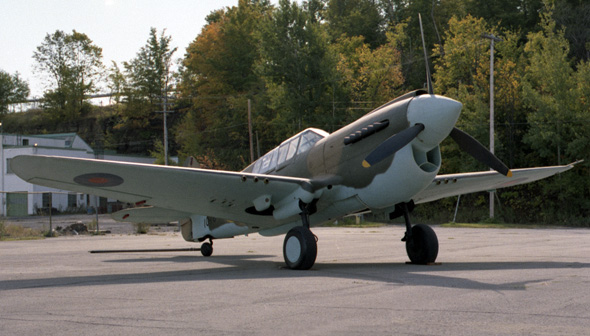 P-40E Mark 1 AL135 (RCAF 1076) at Canada Aviation and Space Museum, Ottawa
P-40E Mark 1 AL135 (RCAF 1076) at Canada Aviation and Space Museum, Ottawa
P-40E (serial number AL135; RCAF # 1076) is on display at the Canada Aviation Museum in Ottawa. This aircraft served in 135 Squadron and did not fly with 111.
One of 111 Squadron's P-40s (P-40E AK 875, RCAF # 1047) survived the Aleutian Campaign and the war. It has been restored and is in the Collection of the United States National Air and Space Museum in Washington, D.C. It is on display in the Boeing Aviation Hangar at the Steven F. Udvar-Hazy Center, Chantilly, VA.
They went into service early in the new year of 1941 and, over time, P-40s were being replaced by Spitfires and Mustangs, they continued to be used in many different theatres right through to the end of the war. And they adapted fairly well to dive bombing tasks when the faster aircraft took over the fighter role.
Even though the enemy fighters could out-perform the P-40, the Kittyhawk was rugged and versatile, well armed and armoured. In the hands of experienced pilots, it proved able to take the battle to the enemy. There are plenty of fans of the P-40. Press here to see the Wikipedia entry that lovers of the P-40 have put together. Press here to see a comparison between the P-40 and the Japanese Zero
The P-40 did have its idiosyncracies, though. We have first-hand reports from two members of 111 Squadron's ground crew: Sergeant (Air Frame Mechanic) Lou Wise and Corporal (Armourer) Max Crandall and from one post-war civilian owner of a P-40. They had these things to say about the mechanics of the Kittyhawk:
One of 111 Squadron's P-40s (P-40E AK 875, RCAF # 1047) survived the Aleutian Campaign and the war. It has been restored and is in the Collection of the United States National Air and Space Museum in Washington, D.C. It is on display in the Boeing Aviation Hangar at the Steven F. Udvar-Hazy Center, Chantilly, VA.
They went into service early in the new year of 1941 and, over time, P-40s were being replaced by Spitfires and Mustangs, they continued to be used in many different theatres right through to the end of the war. And they adapted fairly well to dive bombing tasks when the faster aircraft took over the fighter role.
Even though the enemy fighters could out-perform the P-40, the Kittyhawk was rugged and versatile, well armed and armoured. In the hands of experienced pilots, it proved able to take the battle to the enemy. There are plenty of fans of the P-40. Press here to see the Wikipedia entry that lovers of the P-40 have put together. Press here to see a comparison between the P-40 and the Japanese Zero
The P-40 did have its idiosyncracies, though. We have first-hand reports from two members of 111 Squadron's ground crew: Sergeant (Air Frame Mechanic) Lou Wise and Corporal (Armourer) Max Crandall and from one post-war civilian owner of a P-40. They had these things to say about the mechanics of the Kittyhawk:
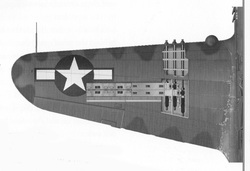
1) Corporal Max Crandall On the six 50 caliber machine guns:
"The P-40 carried three fifty calibre Browning Colt machine guns on each wing. The guns were cocked hydraulically and those hydraulics gave us so much trouble that we eventually disconnected them entirely, and from then on the guns were cocked manually before the aircraft went up. The only disadvantage to this was the fact that the pilot could no longer cock the guns from the cockpit, should one or more misfire for any reason. This wasn't a serious problem, though, as these guns were very dependable, but they had to be properly serviced." (Farm Boy Goes to War, page 23)
"We Canadians realized what effect the weather would have on our guns, especially a finely-machined weapon like the Browning Colt. We had one tent which we used as a shop and we made it a routine practice to remove the guns of each aircraft once a week - replace these with spares and proceed to strip, clean off any rust spots and re-oil these guns with a light gun oil." (Ibid, page 33). Later, on page 37, he reports that their planes' guns performed flawlessly in attacks against the Japanese on Kiska Island. Any guns that were not so maintained had their firing pins become rusted to the breech blocks making the guns useless.
Wing illustration borrowed from Tony Holmes' beautiful and enlightening book: Dogfight The Greatest Air Duels of World War II, Osprey Publishing Ltd, 2011, page 169. The diagram is only a hint of the level of care and eye for detail he brought to the analysis of the P40's strengths and weaknesses against one of its most intense rivals, the Japanese Nakajima Ki-43 "Oscar" in the South Pacific theatre.
"The P-40 carried three fifty calibre Browning Colt machine guns on each wing. The guns were cocked hydraulically and those hydraulics gave us so much trouble that we eventually disconnected them entirely, and from then on the guns were cocked manually before the aircraft went up. The only disadvantage to this was the fact that the pilot could no longer cock the guns from the cockpit, should one or more misfire for any reason. This wasn't a serious problem, though, as these guns were very dependable, but they had to be properly serviced." (Farm Boy Goes to War, page 23)
"We Canadians realized what effect the weather would have on our guns, especially a finely-machined weapon like the Browning Colt. We had one tent which we used as a shop and we made it a routine practice to remove the guns of each aircraft once a week - replace these with spares and proceed to strip, clean off any rust spots and re-oil these guns with a light gun oil." (Ibid, page 33). Later, on page 37, he reports that their planes' guns performed flawlessly in attacks against the Japanese on Kiska Island. Any guns that were not so maintained had their firing pins become rusted to the breech blocks making the guns useless.
Wing illustration borrowed from Tony Holmes' beautiful and enlightening book: Dogfight The Greatest Air Duels of World War II, Osprey Publishing Ltd, 2011, page 169. The diagram is only a hint of the level of care and eye for detail he brought to the analysis of the P40's strengths and weaknesses against one of its most intense rivals, the Japanese Nakajima Ki-43 "Oscar" in the South Pacific theatre.
2) Sergeant Lou Wise: On the P-40's engine and brakes
"As we became familiar with the Kittyhawks, we found that the brakes were a problem for the pilots and ground crew alike." (Wise, Lou, Chapter IV The Alaskan Adventure, Unpublished manuscript). When I asked Lou what he meant by that statement, he explained to me that the Allison engine in the Kitty was extremely prone to "load up". By that he meant that if left to idle at too-low RPM, the engine would become so choked with carbon that significant maintenance would be required. To combat this problem, pilots had to keep the engine turning over at fairly high speeds while taxiing. That meant that they had to keep control of the aircraft on the ground with heavy braking. The result was that the brake pads became glazed and increasingly less effective. It was hard for pilots (or taxiing ground crew - sergeants were allowed to start up and taxi an aircraft) to be precise in their brake pressure. There were two kinds of errors: one was overshooting and possibly ramming something and the other was a rapid nose-over.
"As we became familiar with the Kittyhawks, we found that the brakes were a problem for the pilots and ground crew alike." (Wise, Lou, Chapter IV The Alaskan Adventure, Unpublished manuscript). When I asked Lou what he meant by that statement, he explained to me that the Allison engine in the Kitty was extremely prone to "load up". By that he meant that if left to idle at too-low RPM, the engine would become so choked with carbon that significant maintenance would be required. To combat this problem, pilots had to keep the engine turning over at fairly high speeds while taxiing. That meant that they had to keep control of the aircraft on the ground with heavy braking. The result was that the brake pads became glazed and increasingly less effective. It was hard for pilots (or taxiing ground crew - sergeants were allowed to start up and taxi an aircraft) to be precise in their brake pressure. There were two kinds of errors: one was overshooting and possibly ramming something and the other was a rapid nose-over.
Here is a description of the incident as recorded in the Daily Diary:
"Patricia Bay, B.C., March 5, 1942 The first accident we have had for some time, over a month in fact, occurred today. Kitty Hawk 863, piloted by Pilot Officer Ingalls, nosed over on the runway after landing. The cause was found to be seizing of the brakes, so the accident was unavoidable."
"Patricia Bay, B.C., March 5, 1942 The first accident we have had for some time, over a month in fact, occurred today. Kitty Hawk 863, piloted by Pilot Officer Ingalls, nosed over on the runway after landing. The cause was found to be seizing of the brakes, so the accident was unavoidable."
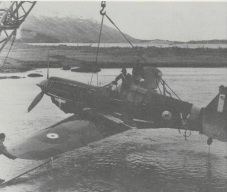
Outrunning the runway, the other consequence of faulty brakes, could create
some embarrassing moments. This is a picture of Warrant Officer II Red McLeod's P-40E being fished out of the ocean. On April 19, 1943, according to the Squadron Daily Diary, while landing AL 194, "He crashed off the end of the runway into the ocean". He was not hurt nor was the Kitty very damaged.
(Photo by Department of National Defence PMR 75-603)
some embarrassing moments. This is a picture of Warrant Officer II Red McLeod's P-40E being fished out of the ocean. On April 19, 1943, according to the Squadron Daily Diary, while landing AL 194, "He crashed off the end of the runway into the ocean". He was not hurt nor was the Kitty very damaged.
(Photo by Department of National Defence PMR 75-603)
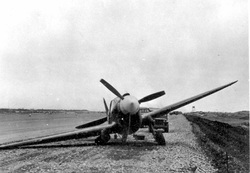
3) George Maude: On the landing gear
George Maude bought a P-40 in a war surplus sale in 1946 (he also bought three Bolingbroke bombers). He told me about a further idiosyncrasy of the P-40. The landing gear could not be depended upon to lock itself into a secure in-place position just before landing. The prudent pilot needed to use a hand crank to be sure that it was locked and ready for landing.
Of course, in the excitement of a tricky landing, this detail could easily be forgotten. The Squadron Daily Diary has many accounts of landing gear failure.
Example: from the Daily Diary dated Patricia Bay, April 18, 1942: "The only pilot who got away solo on the Kittyhawk today was P/O Stiles and he thrilled the spectators when he made a very unoriginal attempt to land with the wheels up; however, he reacted quickly to the persuasive power of a red Verys signal and went around again to make a successful landing."
(Photo of P-40 with collapsed starboard landing gear from the Deparmtent of National Defence, courtesy of Captain Fred Paradie)
George Maude bought a P-40 in a war surplus sale in 1946 (he also bought three Bolingbroke bombers). He told me about a further idiosyncrasy of the P-40. The landing gear could not be depended upon to lock itself into a secure in-place position just before landing. The prudent pilot needed to use a hand crank to be sure that it was locked and ready for landing.
Of course, in the excitement of a tricky landing, this detail could easily be forgotten. The Squadron Daily Diary has many accounts of landing gear failure.
Example: from the Daily Diary dated Patricia Bay, April 18, 1942: "The only pilot who got away solo on the Kittyhawk today was P/O Stiles and he thrilled the spectators when he made a very unoriginal attempt to land with the wheels up; however, he reacted quickly to the persuasive power of a red Verys signal and went around again to make a successful landing."
(Photo of P-40 with collapsed starboard landing gear from the Deparmtent of National Defence, courtesy of Captain Fred Paradie)
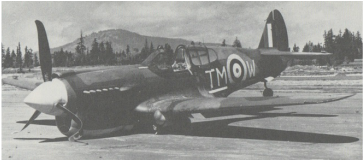
Then again soon after, on May 1, 1942: "After a routine
air-to-ground firing exercise, Sgt Maxmen, low on petrol, landed at Bellingham, refueled and on landing at our base, the undercarriage of his aircraft, AL218, collapsed and the aircraft came to rest on its belly in the centre of No. 1 runway with wrecked undercarriage and airscrew."
(Photo of Sgt Maxmen''s P-40E is by Department of National Defence: PMR 1490))
And on the next day, May 2, "Excitement reigned supreme again this morning when Sgt Clark was forced to make an emergency belly landing on No. 2 runway. His undercarriage became unservicable when on a previous attempt at landing he buckled the port oleo leg rendering his undercarriage useless and so necessitating a belly landing, which he made perfectly." (The aircraft was P-40E, Mark 1 AK 982, RCAF # 1065).
air-to-ground firing exercise, Sgt Maxmen, low on petrol, landed at Bellingham, refueled and on landing at our base, the undercarriage of his aircraft, AL218, collapsed and the aircraft came to rest on its belly in the centre of No. 1 runway with wrecked undercarriage and airscrew."
(Photo of Sgt Maxmen''s P-40E is by Department of National Defence: PMR 1490))
And on the next day, May 2, "Excitement reigned supreme again this morning when Sgt Clark was forced to make an emergency belly landing on No. 2 runway. His undercarriage became unservicable when on a previous attempt at landing he buckled the port oleo leg rendering his undercarriage useless and so necessitating a belly landing, which he made perfectly." (The aircraft was P-40E, Mark 1 AK 982, RCAF # 1065).
There were attributes of the P-40 that made the pilots like them. The aircraft was rugged and could withstand a lot of abuse. A very desireable quality in a fighting machine. Flight Lieutenant (Pilot) Walter "Wally" Ward put in a lot of time in fighter aircraft (118 Squadron, 111 Squadron, 440 Squadron), flew the Hawker Hurricane, the Hawker Typhoon and the Curtiss Kittyhawk. In a recent conversation, he pointed out another aspect of the P-40. "I did enjoy flying the Kittyhawk. American aircraft didn't go short on comfort. They seemed to have everything there that makes it easy for the Pilot. The British aircraft, they're, well, a little bit more functional and not quite as comfortable as the American aircraft. The P-40 was a great airplane. It was far more comfortable. They had a heater in them. There was no heater in the Typhoon."
|
British and Commonwealth allies called the P-40 the Kittyhawk. The USAAF referred to the P-40 D and later models as the Warhawk.
Click here to see a YouTube video of two P-40s in a dogfight simulation. Click here to see the website of the Canadian Warplane Heritage Museum. Click here to see William Maloney's Vintage Wings of Canada where these old birds are being lovingly restored. Click here to see the Maude Family's war surplus P-40E thoroughly restored. And be amused by the process they had to go through to get the job done. P-40 Cockpit photo taken by R. Ward and included in Ray Wagner's Profile Publications monograph on the P-40 entitled The Curtiss P-40 Kittyhawk I - IV, Monograph #136 The publication is not dated but you could buy one for 50 cents at the time so... |
The North American Harvard Mark II
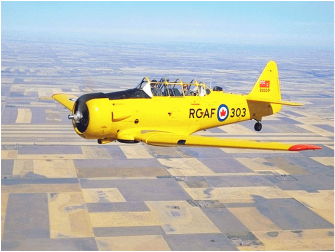
The squadron had a Harvard Mark II Trainer (sometimes two) at its disposal to help pilots fresh out of Flight School to adapt from the relatively simple and slow basic trainer aircraft to the high performance fighter aircraft. They also used the Harvard for running errands between bases in Alaska and the Aleutians.
Harvard was the name used by the RAF and the RCAF. The USAAF called her the AT-6 and referred to her affectionately as the Texan. This aircraft was very rugged, forgiving and versatile. It was used in training virtually all kinds of aerial warfare. The first Harvard flew in 1935. In all, nearly 22,000 were built. They continued to be used as the basic flight trainer well past the end of WWII. Ironically, I suppose, the post-war German and Japanese air forces used this aircraft as their training aircraft as did most of the world's air forces.
Specifications:
POWER PLANT: Supercharged PRATT & WHITNEY R-1340-S3H1 radial piston engine, developing 600 hp @ 2250 rpm
PERFORMANCE: MAXIMUM SPEED: 156 knots; INITIAL CLIMB RATE: 1,359 ft/minute; RANGE: 740 miles; ENDURANCE: 8 hours; SERVICE CEILING: 22,000 ft.
FUEL CONSUMPTION: 30 gallons/ hr @ 10,000 ft.
WEIGHT: 3,995 lbs empty, maximum take-off: 5,750 lbs.
LENGTH: 28' 11" SPAN: 42' HEIGHT: 9' 9"
The Harvards that appeared on No. 111 (F) Squadron's complement were:
Harvard II #3147, Manufacturer's #: 75-3421. Also served with 115 Squadron in Western Air Command
Harvard II #3195, Manufacturer's #: 75-3469. Served in Eastern flying schools before going to Western Air Command in the fall of 1942
and Harvard II #3824, Manufacturer's # 81-4091. Also served with 115 Squadron, Patricia Bay
To see how current-day lovers of the Harvard feel about it, press here.
The photo of the Harvard was taken from www.VintageWings.ca See the site for some great shots and sounds of No. 43 in flight and some history of the Harvard as well as beautiful studies of other well-loved (by many) war planes. On the site, they note that No. 43 is "painted in the markings of Harvard 2866 - known to have been flown by John Gillespie Magee, author of the poem "High Flight." It is painted with the markings of No. 2 Service Flying Training School, Uplands Air Force Base, near Ottawa, Ontario.
Harvard was the name used by the RAF and the RCAF. The USAAF called her the AT-6 and referred to her affectionately as the Texan. This aircraft was very rugged, forgiving and versatile. It was used in training virtually all kinds of aerial warfare. The first Harvard flew in 1935. In all, nearly 22,000 were built. They continued to be used as the basic flight trainer well past the end of WWII. Ironically, I suppose, the post-war German and Japanese air forces used this aircraft as their training aircraft as did most of the world's air forces.
Specifications:
POWER PLANT: Supercharged PRATT & WHITNEY R-1340-S3H1 radial piston engine, developing 600 hp @ 2250 rpm
PERFORMANCE: MAXIMUM SPEED: 156 knots; INITIAL CLIMB RATE: 1,359 ft/minute; RANGE: 740 miles; ENDURANCE: 8 hours; SERVICE CEILING: 22,000 ft.
FUEL CONSUMPTION: 30 gallons/ hr @ 10,000 ft.
WEIGHT: 3,995 lbs empty, maximum take-off: 5,750 lbs.
LENGTH: 28' 11" SPAN: 42' HEIGHT: 9' 9"
The Harvards that appeared on No. 111 (F) Squadron's complement were:
Harvard II #3147, Manufacturer's #: 75-3421. Also served with 115 Squadron in Western Air Command
Harvard II #3195, Manufacturer's #: 75-3469. Served in Eastern flying schools before going to Western Air Command in the fall of 1942
and Harvard II #3824, Manufacturer's # 81-4091. Also served with 115 Squadron, Patricia Bay
To see how current-day lovers of the Harvard feel about it, press here.
The photo of the Harvard was taken from www.VintageWings.ca See the site for some great shots and sounds of No. 43 in flight and some history of the Harvard as well as beautiful studies of other well-loved (by many) war planes. On the site, they note that No. 43 is "painted in the markings of Harvard 2866 - known to have been flown by John Gillespie Magee, author of the poem "High Flight." It is painted with the markings of No. 2 Service Flying Training School, Uplands Air Force Base, near Ottawa, Ontario.
Thanks for your interest in these men
See the page entitled "Chronology" for an overview of events in the short life of this squadron.
See the page entitled "Chronology" for an overview of events in the short life of this squadron.

